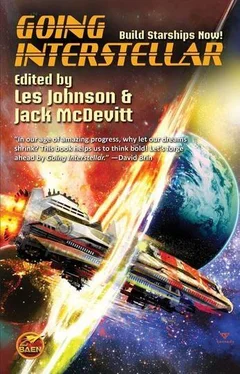So I’ll sing my grandchildren to sleep as I sang my children to sleep: to stories of our once and future voyages.
The big ship sails in the vacuum, oh.
If we actually achieve a serious space flight capability, it’s likely we will spend a long time in the Solar System before anybody actually makes for the high country. With experience, propulsion systems will improve, as will life support. What is now little more than a dream may one day become no more than a sporting event, a race, perhaps, through the Saturnian rings. Will this type of casual event signal that we are ready to move on? Perhaps. A better indicator, however, might arrive when we reach a point at which space travel begins to develop its own mythology.
Mike Resnick has won five Hugos and been nominated a record thirty-five times.
* * *
So let me tell you aboutthe Great Regatta of 2237, because the press had it wrong, as usual, and when was the last time the self-appointed pundits ever knew anything except what other self-appointed pundits were thinking?
The public had grown increasingly weary of races on Earth’s oceans. After all, the oceans were so …well … limiting . Lift your gaze, the reasoning went, and there’s a whole universe up there, and it’s a lot bigger than an ocean. Okay, we couldn’t reach most of it, couldn’t even visit Alpha Centauri during one lifetime, let alone make the return flight. But we could reach just about any place in the solar system, and even if the distances weren’t measured in parsecs, they stirred the imagination the way mere miles and fathoms no longer could.
There were six ships entered in the race. Five were sleek, bullet-shaped vessels, powered by fission or fusion—and then there was the Argo , the only ship in the Regatta that made its way through the void by the use of solar sails.
The course was mapped out by the most sophisticated computers: they would start from orbit—four of the ships had been built in space and would die having never touched down on a planetary surface—and each ship would have to pass within a thousand miles of four buoys that would register their passage. The designers didn’t want to chance losing a ship due to a gas giant’s gravity, so while they put one buoy in orbit around Mars, the other three would be in position not around Jupiter, Saturn and Uranus, but rather their moons: Ganymede, Titan, and Umbriel.
May 1 was a special day in many cultures—not for the reasons it once was, at least not in most countries—and it was decided that the race would begin at exactly twelve o’clock noon, Greenwich Mean Time, on that date.
The ships could choose any course they wanted, which was meaningful since their goals were in constant motion. Once the race began, they were not permitted to communicate with each other, even to warn of dangers such as ion storms or meteor showers. And finally, if a ship touched down on any solid surface—planet, moon, asteroid, anything—for any reason, it would be disqualified.
It was the Argo that caught the public’s fancy, partially because solar sails seemed somehow romantic, conjuring up visions of the sailing ships of yore, and partially because of the captain. His name—and no one except the public believed it could possibly be his real one—was FarTrekker Jones, with the capital T right in the middle of it, and they couldn’t have been more taken by a name if he’d chosen Odysseus or Horatio Hornblower.
He shared the Argo with two others, a co-pilot and a navigator—he didn’t trust navigational computers, though of course the ship had one—and the three of them were a hard-bitten lot. No one knew what had driven them to space (I almost said “driven them to sea”), and they weren’t much for giving interviews—but the people loved them anyway, and if no one knew anything much about them, why, that just lent a little romantic mystery to the race.
They lined the six ships up in orbit, each about five miles from the next, and suddenly they were off and running, or probably I should say off and flying. The Silver Streak jumped out to a quick lead, followed by the Galaxy Roamer . The Argo wasn’t exactly left at the gate—for one thing, they didn’t have a starting gate—but it was soon bringing up the rear.
They reached Mars in fourteen to sixteen days, depending on which ship you were rooting for. The Galaxy Roamer was now in the lead by seven hours, with the Silver Streak and McGinty’s Marvel five minutes apart in second place, and the Argo still bringing up the rear.
The first five ships followed a predetermined route to get to Ganymede, which was their next checkpoint. It was a reasonable route, and a safe route. They had to go through the Asteroid Belt, of course, but bad stories and worse videos to the contrary, most of the asteroids are so far apart that actually seeing two or three while traversing the Belt breaks the monotony (and monotonous it is, for Jupiter is a lot farther from Mars than Earth is).
But not all the Belt is like that. Some of it is what you might call densely populated, not by people but by asteroids, and in fact there are a few places where there are so many and they are moving so swiftly, that they can be damned dangerous. Moreover, there’s a lot of rubble out there, rocks the size of bricks, or footballs if you prefer, that are so small and so fast that a ship’s sensors will miss half of them, but any one of them, if it hits the right spot at the right angle, can put a ship out of commission …and I mean permanently.
Of course you’ve figured out by now what I’m going to tell you, and you’re right: FarTrekker decided the only way to make up lost time was to take the shortest route to Ganymede, a route the other five ships had avoided because of the danger involved.
A number of media ships had been posted along the route, reporting back on the race, but when the Argo changed its course they followed it only long enough to determine where it was going, and then wisely refused to follow it. As they reported, only a crazy man would take this route, and especially in a ship with a solar sail, which presented a much bigger target to the myriad of flying rocks, and of course once the sail was destroyed the ship would be without motive power. (“What will they do then?” asked one of the self-appointed pundits. “Row?” Twenty-seven other pundits used that same line during the next day, and eleven presented it as their own, which is of course what self-appointed pundits do.)
The Argo entered the Belt, and Knibbs the navigator—no one ever knew his first name—went to work, charting all the asteroids that were big enough to chart, and trying to position the ship so that anything too small to chart was more likely to hit the hull than the solar sail. They figured to be eight days crossing the Belt, but if they made it to the other side, they’d have picked up more than a week on their rivals.
And, oddly enough, they were not touched by so much as a pebble for the first five days. The sail remained intact, they actually were running two hours ahead of schedule, and Knibbs announced that they’d passed through the worst of it, that the asteroids were starting to look like baby planets again, rather than large rocks and small boulders.
And then, on the sixth day, the co-pilot (whose first name was Vladimir, and I won’t bother with his surname since no one could pronounce or spell it anyway), Vladimir was sitting at the control panel when he fell asleep, and his head or his hand—they never knew which, and it doesn’t really matter anyway—brushed against some of the buttons and switches and knobs, and suddenly the Argo was filled with this haunting sound, like a melody you heard when both you and the world were younger and more innocent, and try as you would you could never quite remember it, though you knew it had brought tears to your eyes the one time you’d heard it. In fact, you probably looked for it on and off for years, but privately , because you didn’t know quite how to tell anyone you were looking for a melody that made you cry.
Читать дальше












